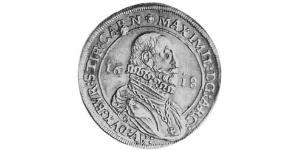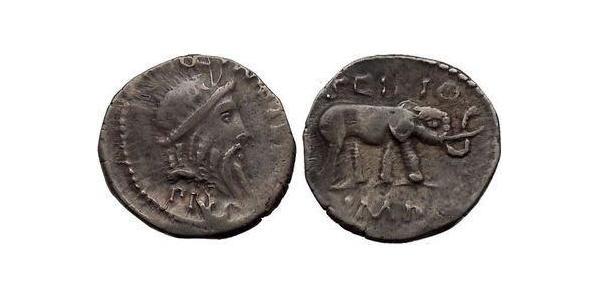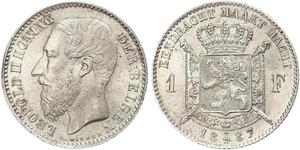[ 5142] Q.Qaecilius Metellus Pius Scipio and P.Licinius Crassus - Silver Denarius (18.5mm, 3.74 gm.) Military mint traveling with Scipio in Africa: 47-46 B.C. Reference: Crawford 459/1. Syd. 1046. Caecilia 47. Lion-headed Janus right, beard braided in ringlets. Elephant standing right. Provided with certificate of authenticity. CERTIFIED AUTHENTIC by Sergey Nechayev, PhD - Numismatic Expert Quintus Caecilius Metellus Pius (ca 130 BC or 127 BC – 63 BC) was a pro-Sullan politician and general. He was named Pius because of his 99 BC petition to return his father from exile and was true to his cognomen for the constance and inflexibility with which he always fought for his father's rehabilitation and return to Rome. He was elected Quaestor in 97 BC, Tribune in 92 and Pontifex Maximus in 81, Praetor in 89 BC, Consul in 80. He withdrew from Rome during the civil war between Marius and Sulla, returning afterward with the latter. As a military figure, he had his first commands in the war in 109-107 BC, when he accompanied his father Quintus Caecilius Metellus Numidicus in Numidia during Jugurthine War, where his father took him as a simple cadet. He was later revealed to be one of the best subordinates of Sulla, but without any other objective than fighting the demagogy with which Marius threatened Rome, never participating in the atrocious violence that marked such a troubled phase of the history of Rome. He was also one of the Roman commanders in the Social War of 90 - 89 BC. A Propraetor at that time, Pius stormed Venusia and killed the general of the Marsi, Quintus Poppaedius Silo. In 87 BC Pius by the order of Senate tried to make peace with the Samnites. Sertorian War Made a Consul in 80 BC, he was then sent to Spain to combat Quintus Sertorius, where Sertorius and Marcus Perpenna Vento faced the Roman power, establishing his bases in Metellinum (today Medellín) Castra Caecilia (today Cáceres), Viccus Caecilius, at the Sierra de Gredos, and at Caeciliana, near Setúbal. During eight years of resistance he was unable to conclusively defeat Sertorius, and it was only after Sertorius' assassination by his own men that the rebels were forced to cede to the military ability of Metellus Pius. Metellus had as a companion in the final phase of the war Gnaeus Pompeius Magnus who was a valuable asset, with whom, despite his greater merit, he shared the glories of the Triumph which was held at the end of 71 BC. Family Relations He married Licinia Crassa Secunda or Minor, daughter of Lucius Licinius Crassus Orator, and wife Mucia Secunda, from whom he had no children. For this reason he adopted his nephew by marriage and son of his second cousin Publius Cornelius Scipio, renamed Quintus Caecilius Metellus Pius Scipio Nasica. He was the son of Quintus Caecilius Metellus Pius's wife's sister Licinia Crassa Prima or Major and Publius Cornelius Scipio Nasica Serapio, who was in turn the son of Publius Cornelius Scipio Nasica Serapio and Caecilia Metella, daughter of Quintus Caecilius Metellus Macedonicus. The Roman Republic was the phase of the ancient Roman civilisation characterised by a republican form of government. It began with the overthrow of the Roman monarchy, c. 509 BC, and lasted over 450 years until its subversion, through a series of civil wars, into the Principate form of government and the Imperial period. The Roman Republic was governed by a complex constitution, which centred on the principles of a separation of powers and checks and balances. The evolution of the constitution was heavily influenced by the struggle between the aristocracy (the patricians), and other talented Romans who were not from famous families, the plebeians. Early in its history, the republic was controlled by an aristocracy of individuals who could trace their ancestry back to the early history of the kingdom. Over time, the laws that allowed these individuals to dominate the government were repealed, and the res ...
Mehr...

|
Beigetragen von:
anonymous 2015-08-18 |
Similar Coin Groups

1 Denarius Römische Kaiserzeit (27BC-395 ...
Diese Gruppe hat 21 Münzen / 19 Preise
Add coin to this group

1 Tetradrachm Antikes Griechenland (1100 ...
Diese Gruppe hat 12 Münzen / 12 Preise
Add coin to this group

1 Thaler Heiliges Römisches Reich (962-1 ...
Diese Gruppe hat 19 Münzen / 18 Preise
Add coin to this group
2025-05-27
- New coin is added to 1 Franc Belgien Silber Leopold II (1835 - 1909)
1 Franc Belgien Silber Leopold II (1835 - 1909)
Diese Gruppe hat 12 Münzen / 10 Preise
⇑
Belgien, Königreich. Leopold II. 1865-1909. Franc 1887. Flämische Legende. K.M. 29.1. Vorzüglich - Stempelglanz
2025-05-23
- Historical Coin Prices
Das könnte Sie auch interessieren:



















